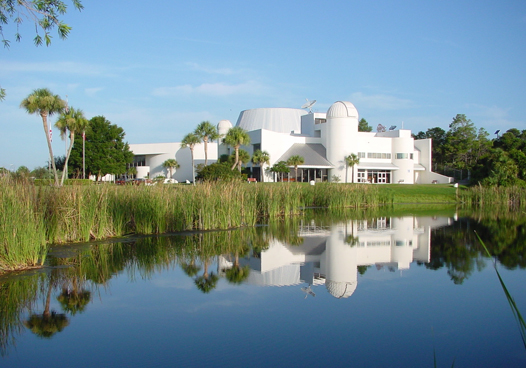The Planetarium- Their world-class planetarium has seating for 210 under a 70-foot dome projection screen. A special lift provides access to the second-story seating for those who would rather not make the climb up the curving stairways. Two star projectors team up to produce a stunningly realistic sky and 3D computer effects. The Minolta Alpha Infinium shines 28,000 little points of light to create the feel of a real skyful of stars, and has auxiliary projectors to add the Sun and Moon. The Evans and Sutherland Digistar is a computer graphics projector capable of flying us through a 3D representation of our universe. The Digistar also is used for any graphic requiring only dots and lines, such as constellation overlays. A superb audio system is capable of achieving concert-level sound for rock laser shows, and putting the feeling behind explosions and rocket liftoffs. The high quality of the sound in our planetarium is something we are all proud of. Five video projectors display moving images in the front half of the planetarium. 32 slide projectors are used for dome-filling “All-Sky” images, wraparound panoramas, and to show high-quality images. Two 3.5 Watt lasers shine bright and colorful light through five projection ports. These machines add animations and special effects that can’t be easily achieved in any other way. Plus, they help to make our laser shows some of the best in the biz.
The Observatory- The BCC Observatory is home to the largest public telescope in Florida which is open every week. Members of the Brevard Astronomical Society operate the telescope, and serve as guides to your own personal tour of the night sky. Planets, fuzzy nebula, double stars, star clusters and galaxies are some of the things you may see on any given night. The telescope is 24 inches in diameter, and uses a 134 pound glass mirror to collect light from distant objects. That light is then reflected back from a second mirror, which effectively “folds” an eighteen-foot light path into a compact seven-foot-long tube. An eyepiece at the back of the telescope then magnifies the image. Normally, we use magnification from about 150 power to over 400 power. Strapped to the side of the main telescope is a six-inch diameter refracting telescope that uses a lens to gather light. At the rear of this fine instrument is a small video camera, which sends a picture to a television monitor near the control desk. We also have recorded images using this telescope to show to visitors when the sky is not cooperating. The telescopes are controlled by a set of two computers. One runs “Starry Night,” commercial software (available in our gift shop!) that presents a simulation of the night sky. Telescope operators can click on any object, and instruct the computers to aim the telscope at that object. These commands go to another computer that runs special software to drive the motors that make the telescope move. These same motors keep the telescope pointed at the same place in the sky as our Earth turns.






